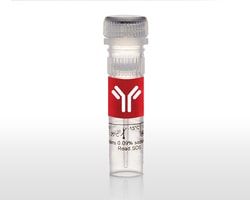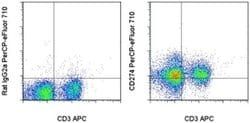50-112-9762
CD273 (B7-DC) Monoclonal Antibody (122), PerCP-eFluor™ 710, eBioscience™, Invitrogen™
Manufacturer: Fischer Scientific
Select a Size
| Pack Size | SKU | Availability | Price |
|---|---|---|---|
| Each of 1 | 50-112-9762-Each-of-1 | In Stock | ₹ 13,528.00 |
50-112-9762 - Each of 1
In Stock
Quantity
1
Base Price: ₹ 13,528.00
GST (18%): ₹ 2,435.04
Total Price: ₹ 15,963.04
Antigen
CD273 (B7-DC)
Classification
Monoclonal
Concentration
0.2 mg/mL
Formulation
PBS with 0.09% sodium azide; pH 7.2
Gene Accession No.
Q9WUL5
Gene Symbols
PDCD1LG2
Purification Method
Affinity chromatography
Regulatory Status
RUO
Gene ID (Entrez)
58205
Content And Storage
4° C, store in dark, DO NOT FREEZE!
Form
Liquid
Applications
Flow Cytometry
Clone
122
Conjugate
PerCP-eFluor 710
Gene
PDCD1LG2
Gene Alias
B7 dendritic cell molecule; B7DC; B7-DC; bA574F11.2; Btdc; Butyrophilin B7-DC; butyrophilin-like protein; CD273; F730015O22Rik; MGC124039; MGC124040; PD1 ligand 2; PD-1 ligand 2; PD-1-ligand 2; PDCD1 ligand 2; PDCD1L2; Pdcd1lg2; Pdl2; PD-L2; Programmed cell death 1 ligand 2; programmed death ligand 2
Host Species
Rat
Quantity
25 μg
Primary or Secondary
Primary
Target Species
Mouse
Product Type
Antibody
Isotype
IgG2a κ
Description
- Description: The 122 monoclonal antibody reacts with mouse B7-DC, also known as PD-L2
- B7-DC, a member of the B7 family, has a predicted molecular weight of approximately 25 kDa and belongs to the Ig superfamily
- The mouse B7-DC has a short cytoplasmic tail (4aa)
- B7-DC is primarily expressed by subpopulations of dendritic cells and monocytes/macrophages in the mouse
- Although B7-DC has structural and sequence similarities to the B7 family, it does not bind CD28/CTLA-4, rather it is a ligand for PD-1
- The interactions between PD-1 and B7-DC/PD-L2 have been reported to be involved in costimulation or suppression of T cell proliferation depending on state of cellular activation
- 122 has been demonstrated to block binding of TY25 (Cat
- No
- 14-5986), another mAb specific for mouse B7-DC
- Applications Reported: This 122 antibody has been reported for use in flow cytometric analysis
- Applications Tested: This 122 antibody has been tested by flow cytometric analysis of mouse bone marrow derived dendritic cells
- This can be used at less than or equal to 0.5 μg per test
- A test is defined as the amount (μg) of antibody that will stain a cell sample in a final volume of 100 μL
- Cell number should be determined empirically but can range from 10^5 to 10^8 cells/test
- It is recommended that the antibody be carefully titrated for optimal performance in the assay of interest
- Programmed death-ligand 2 (PD-L2), or B7-DC, is a member of the B7 ligand family within the immunoglobulin superfamily that, along with programmed death-ligand 1 (PD-L1), acts as a ligand for programmed cell death protein 1 (PD-1)
- Though expressed primarily in dendritic cells, PD-L2 expression can be induced on a wide variety of immune and non-immune cells depending on the microenvironment
- PD-L2 expression is particularly upregulated in the presence of Th2 cytokine, IL-4, as well as Th1 cytokines, TNF-alpha and IFN-gamma to a lesser degree
- While generally expressed at lower levels compared to PD-L1, PD-L2 demonstrates a 2 to 6 times higher relative affinity to PD-1 than PD-L1
- PD-1 and its ligands are referred to as inhibitory immune checkpoint molecules in that they provide useful negative feedback during physiological homeostasis
- Ligation of PD-L2 or PD-L1 inhibits activation, proliferation, and cytokine secretion (e.g
- IFN-gamma, IL-10) in T cells, μgtimately dampening immune response
- Conversely, studies have shown that PD-L2 can also stimulate T cell proliferation and cytokine production, even in PD-1-deficient T cells, suggesting additional receptors
- Recent studies have concluded that PD-L2 also binds to a second receptor, repulsive guidance molecule b (RGMb), which was originally identified as a receptor for bone morphogenetic proteins (BMPs)
- RGMb is expressed in the central nervous system, as well as in macrophages, however, its role in immunity is only beginning to emerge
- Interaction between PD-L2 and RGMb regulates the development of respiratory tolerance in the lung through BMP and/or neogenin signaling pathways
- The naturally occurring human PD-L2 monomer consists of a 201-amino-acid extracellular domain, a 21-amino-acid transmembrane domain, and a 32-amino-acid cytoplasmic domain.
Compare Similar Items
Show Difference
Antigen: CD273 (B7-DC)
Classification: Monoclonal
Concentration: 0.2 mg/mL
Formulation: PBS with 0.09% sodium azide; pH 7.2
Gene Accession No.: Q9WUL5
Gene Symbols: PDCD1LG2
Purification Method: Affinity chromatography
Regulatory Status: RUO
Gene ID (Entrez): 58205
Content And Storage: 4° C, store in dark, DO NOT FREEZE!
Form: Liquid
Applications: Flow Cytometry
Clone: 122
Conjugate: PerCP-eFluor 710
Gene: PDCD1LG2
Gene Alias: B7 dendritic cell molecule; B7DC; B7-DC; bA574F11.2; Btdc; Butyrophilin B7-DC; butyrophilin-like protein; CD273; F730015O22Rik; MGC124039; MGC124040; PD1 ligand 2; PD-1 ligand 2; PD-1-ligand 2; PDCD1 ligand 2; PDCD1L2; Pdcd1lg2; Pdl2; PD-L2; Programmed cell death 1 ligand 2; programmed death ligand 2
Host Species: Rat
Quantity: 25 μg
Primary or Secondary: Primary
Target Species: Mouse
Product Type: Antibody
Isotype: IgG2a κ
Antigen:
CD273 (B7-DC)
Classification:
Monoclonal
Concentration:
0.2 mg/mL
Formulation:
PBS with 0.09% sodium azide; pH 7.2
Gene Accession No.:
Q9WUL5
Gene Symbols:
PDCD1LG2
Purification Method:
Affinity chromatography
Regulatory Status:
RUO
Gene ID (Entrez):
58205
Content And Storage:
4° C, store in dark, DO NOT FREEZE!
Form:
Liquid
Applications:
Flow Cytometry
Clone:
122
Conjugate:
PerCP-eFluor 710
Gene:
PDCD1LG2
Gene Alias:
B7 dendritic cell molecule; B7DC; B7-DC; bA574F11.2; Btdc; Butyrophilin B7-DC; butyrophilin-like protein; CD273; F730015O22Rik; MGC124039; MGC124040; PD1 ligand 2; PD-1 ligand 2; PD-1-ligand 2; PDCD1 ligand 2; PDCD1L2; Pdcd1lg2; Pdl2; PD-L2; Programmed cell death 1 ligand 2; programmed death ligand 2
Host Species:
Rat
Quantity:
25 μg
Primary or Secondary:
Primary
Target Species:
Mouse
Product Type:
Antibody
Isotype:
IgG2a κ
Antigen: CD28
Classification: Monoclonal
Concentration: 1 mg/mL
Formulation: PBS with no preservative; pH 7.2
Gene Accession No.: 0
Gene Symbols: Cd28
Purification Method: Affinity chromatography
Regulatory Status: RUO
Gene ID (Entrez): 403646
Content And Storage: 4° C
Form: Liquid
Applications: Flow Cytometry, Functional Assay
Clone: 1C6
Conjugate: Functional Grade
Gene: Cd28
Gene Alias: antigen CD28; CD28; CD28 antigen; CD28 antigen (Tp44); CD28 isoform; CD28 isoform 2; Cd28 molecule; CD28 precursor protein; CD28 protein; CD28 protein precursor; CD28RNA; cell surface protein; CHT28; contains partial extracellular domain; costimulatory molecule B7 receptor CD28; EGK_04709; MGC138290; sCD28; soluble CD28; T44; T-cell costimulatory molecule CD28; T-cell costimulatory molecule Tp44; T-cell-specific surface glycoprotein CD28; T-cell-specific surface glycoprotein CD28 homolog; TP44
Host Species: Mouse
Quantity: 100 μg
Primary or Secondary: Primary
Target Species: Canine
Product Type: Antibody
Isotype: IgG1 κ
Antigen:
CD28
Classification:
Monoclonal
Concentration:
1 mg/mL
Formulation:
PBS with no preservative; pH 7.2
Gene Accession No.:
0
Gene Symbols:
Cd28
Purification Method:
Affinity chromatography
Regulatory Status:
RUO
Gene ID (Entrez):
403646
Content And Storage:
4° C
Form:
Liquid
Applications:
Flow Cytometry, Functional Assay
Clone:
1C6
Conjugate:
Functional Grade
Gene:
Cd28
Gene Alias:
antigen CD28; CD28; CD28 antigen; CD28 antigen (Tp44); CD28 isoform; CD28 isoform 2; Cd28 molecule; CD28 precursor protein; CD28 protein; CD28 protein precursor; CD28RNA; cell surface protein; CHT28; contains partial extracellular domain; costimulatory molecule B7 receptor CD28; EGK_04709; MGC138290; sCD28; soluble CD28; T44; T-cell costimulatory molecule CD28; T-cell costimulatory molecule Tp44; T-cell-specific surface glycoprotein CD28; T-cell-specific surface glycoprotein CD28 homolog; TP44
Host Species:
Mouse
Quantity:
100 μg
Primary or Secondary:
Primary
Target Species:
Canine
Product Type:
Antibody
Isotype:
IgG1 κ
Antigen: CD123
Classification: Monoclonal
Concentration: 5 μL/Test
Formulation: PBS with 0.2% BSA and 0.09% sodium azide; pH 7.2
Gene Accession No.: P26951
Gene Symbols: IL3RA
Purification Method: Affinity chromatography
Regulatory Status: RUO
Gene ID (Entrez): 3563
Content And Storage: 4° C, store in dark, DO NOT FREEZE!
Form: Liquid
Applications: Flow Cytometry
Clone: 7G3
Conjugate: eFluor 450
Gene: IL3RA
Gene Alias: CD123; CD123 antigen; CDw123; Cyrl; cytokine receptor-like protein CYRL; hIL-3Ra; Il-3 alpha subunit; IL-3 receptor alpha chain; IL-3 receptor alpha SP2 isoform; IL-3 receptor subunit alpha; IL3R; IL-3R subunit alpha; Il3ra; IL-3RA; IL-3R-alpha; IL3RAY; IL3RX; IL3RY; interleukin 3 receptor subunit alpha; interleukin 3 receptor, alpha; interleukin 3 receptor, alpha (low affinity); interleukin 3 receptor, alpha chain; interleukin-3 receptor class II alpha chain; Interleukin-3 receptor subunit alpha; Sut-1
Host Species: Mouse
Quantity: 100 Tests
Primary or Secondary: Primary
Target Species: Human, Non-human Primate
Product Type: Antibody
Isotype: IgG2a κ
Antigen:
CD123
Classification:
Monoclonal
Concentration:
5 μL/Test
Formulation:
PBS with 0.2% BSA and 0.09% sodium azide; pH 7.2
Gene Accession No.:
P26951
Gene Symbols:
IL3RA
Purification Method:
Affinity chromatography
Regulatory Status:
RUO
Gene ID (Entrez):
3563
Content And Storage:
4° C, store in dark, DO NOT FREEZE!
Form:
Liquid
Applications:
Flow Cytometry
Clone:
7G3
Conjugate:
eFluor 450
Gene:
IL3RA
Gene Alias:
CD123; CD123 antigen; CDw123; Cyrl; cytokine receptor-like protein CYRL; hIL-3Ra; Il-3 alpha subunit; IL-3 receptor alpha chain; IL-3 receptor alpha SP2 isoform; IL-3 receptor subunit alpha; IL3R; IL-3R subunit alpha; Il3ra; IL-3RA; IL-3R-alpha; IL3RAY; IL3RX; IL3RY; interleukin 3 receptor subunit alpha; interleukin 3 receptor, alpha; interleukin 3 receptor, alpha (low affinity); interleukin 3 receptor, alpha chain; interleukin-3 receptor class II alpha chain; Interleukin-3 receptor subunit alpha; Sut-1
Host Species:
Mouse
Quantity:
100 Tests
Primary or Secondary:
Primary
Target Species:
Human, Non-human Primate
Product Type:
Antibody
Isotype:
IgG2a κ
Antigen: CD223 (LAG-3)
Classification: Monoclonal
Concentration: 0.5 mg/mL
Formulation: PBS with 0.09% sodium azide; pH 7.2
Gene Accession No.: Q61790
Gene Symbols: LAG3
Purification Method: Affinity chromatography
Regulatory Status: RUO
Gene ID (Entrez): 16768
Content And Storage: 4° C, store in dark, DO NOT FREEZE!
Form: Liquid
Applications: Flow Cytometry
Clone: eBioC9B7W (C9B7W)
Conjugate: FITC
Gene: LAG3
Gene Alias: Activation-induced cytidine deaminase-linked autoimmunity protein; Aida; CD223; FDC; LAG3; LAG-3; Ly66; lymphocyte activating 3; lymphocyte activation gene 3 protein; lymphocyte-activation gene 3; Secreted lymphocyte activation gene 3 protein; sLAG 3; sLAG3; sLAG-3; soluble LAG 3lymphocyte activating 3; soluble LAG3
Host Species: Rat
Quantity: 100 μg
Primary or Secondary: Primary
Target Species: Mouse
Product Type: Antibody
Isotype: IgG1 κ
Antigen:
CD223 (LAG-3)
Classification:
Monoclonal
Concentration:
0.5 mg/mL
Formulation:
PBS with 0.09% sodium azide; pH 7.2
Gene Accession No.:
Q61790
Gene Symbols:
LAG3
Purification Method:
Affinity chromatography
Regulatory Status:
RUO
Gene ID (Entrez):
16768
Content And Storage:
4° C, store in dark, DO NOT FREEZE!
Form:
Liquid
Applications:
Flow Cytometry
Clone:
eBioC9B7W (C9B7W)
Conjugate:
FITC
Gene:
LAG3
Gene Alias:
Activation-induced cytidine deaminase-linked autoimmunity protein; Aida; CD223; FDC; LAG3; LAG-3; Ly66; lymphocyte activating 3; lymphocyte activation gene 3 protein; lymphocyte-activation gene 3; Secreted lymphocyte activation gene 3 protein; sLAG 3; sLAG3; sLAG-3; soluble LAG 3lymphocyte activating 3; soluble LAG3
Host Species:
Rat
Quantity:
100 μg
Primary or Secondary:
Primary
Target Species:
Mouse
Product Type:
Antibody
Isotype:
IgG1 κ







